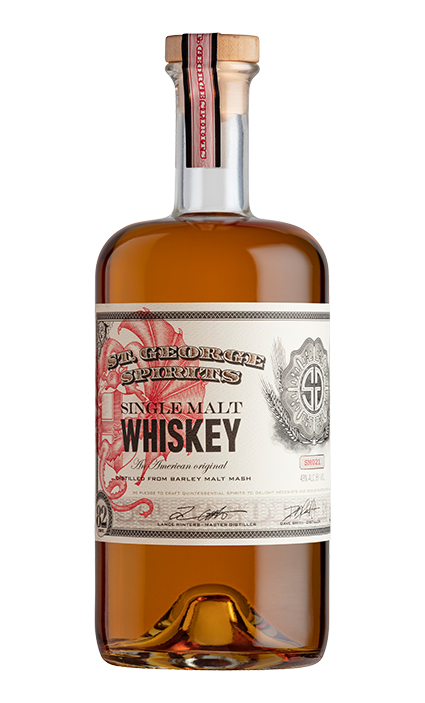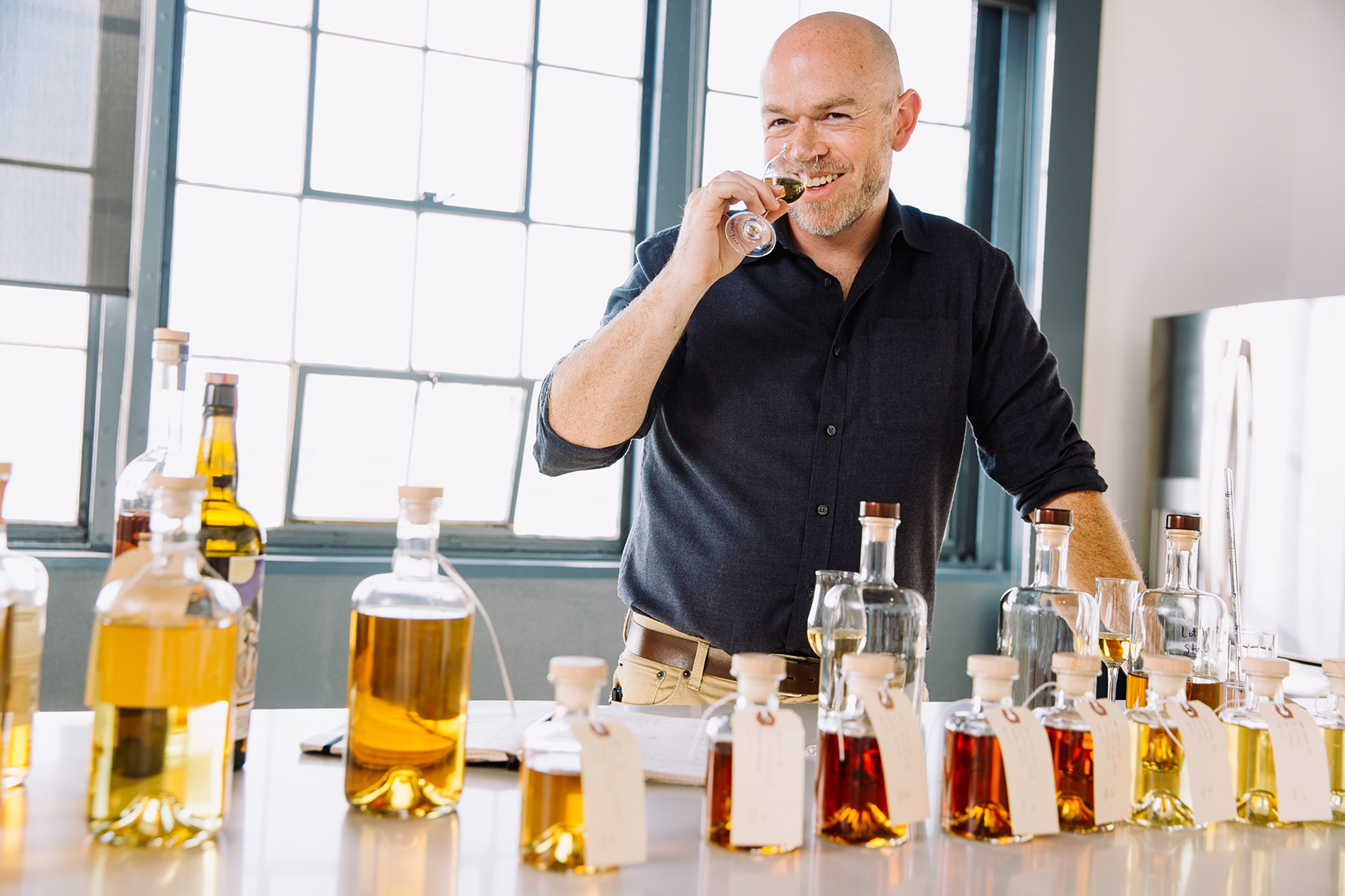St George Spirits makes damn good Single Malt whiskey, but even by their high standards, Lot 21 is something special.
Some weeks back, I found myself behind a velvet curtain in a black windowless room drinking through all things St George at Employees Only in Los Angeles. Spirits writers filled the space, which otherwise featured a 10-seat bar in the corner farthest from the entrance. During the course of the night, three things of particular interest presented themselves: a Vesper Martini play dubbed Midnight Prayer, the Lot 21, and Head Distiller Dave Smith’s appreciation for the new whiskey, which he showed off like Simba at the beginning of The Lion King.
For those unaware, American Single Malt is like crack to today’s whiskey writer. And each of us attempted, rather embarrassingly, to show off our “knowledge” by asking idiosyncratic questions regarding fermentation, barrel aging, etc. But the point is, St George Single Malt Whiskey, Lot 21 is very good whiskey and should be treated as such.
In this edition of Bottle Breakdown, we catch up with Head Distiller Dave Smith to learn more about what’s inside St George Single Malt Whiskey, Lot 21.

Spirited: How did you get here and why St. George Spirits?
Dave Smith: Initially, I learned fermentation sciences and cellar work from my brother Matt. He’s a wonderfully talented winemaker and he loves sharing his passion to explore wines that are evocative and true to their varietal. Learning from him gave me the experience to be offered an opportunity at St. George. Matt was also the one that told me to say yes if they offered me a job, so I pretty much owe my career to him.
The first thing that Matt told me about St. George Spirits was that Lance and Jörg were really great people and that we needed to go to the distillery when they had raspberries and pears and cherries in during the fall. “Dave, they ferment and distill raspberries and the whole place just smells like jam. It’s amazing.” At that point, distillation was just magic to me and I was fascinated by the idea of capturing flavors and aromatics as a sense of time and space beyond winemaking. After Lance hired me, I figured that I’d learn what I could and do this for a year or so before moving back to the wine world to travel and write. That was nearly eighteen years ago as I just fell down the rabbit hole and fell in love with the joy of distillation.
Spirited: What’s the story behind St. George Single Malt Whiskey and this particular bottling?
DS: This particular bottling is Lot 21, so that’s the 21st release of our Lot series. The real story is that our single malt whiskey program was developed by Lance and Jörg a quarter of a century ago in the late 1990s. There were very few American single malts at that time.
Jörg had founded St. George Spirits in 1982 and had won acclaim in Europe for his eau de vies – unaged fruit brandies. And then Lance showed up in 1996 with a background in brewing and a bottle of his homemade whiskey as a resume. After a year of experimentation, they laid down the first barrels of our single malt whiskey program that would eventually become the Lot series.

Spirited: Where does Lot 21 come from and how does terroir play its part?
DS: We can spend days talking about our distillery. We’re in a retired naval aircraft hangar on the island of Alameda, just off of the coast of Oakland, California. Our barrel storage is just one level a few barrels high with a 40-foot redwood ceiling high above. Between that and the Bay Area’s seasonal temperatures and humidity, all these factors have an impact on the maturation of our whiskey.
Really though, the terroir is us. It’s our POV and desire to create something that’s truly unique. From mash bill to fermentation, distillation, and cask aging, we work really hard to craft spirits that are completely our own.
Adam Rogers, an editor for Wired Magazine and a brilliant author of Proof: The Science of Booze describes that sense of identity as “the fist” which is an old term telegraph operators used as they could tell who was on the other end of the line making those dots and dashes simply by the way that the person did it. No names or visuals were needed. Similarly, we hope that you’ll always recognize a St. George spirit as we love and celebrate distillation as a form of self expression above all else.
Spirited: Ingredients: What’s inside each bottle?
DS: Unicorn tears? Everything that’s good and beautiful in the world? Like every one of our Lot series releases beginning with Lot 1 back in 2000, the mash bill is composed of various roast levels of two-row barley: pale malt, crystal malt, chocolate malt, black patent malt, and Bamberg malt. The two-row is the workhorse of American craft brewing and is the foundation for many American single malts today. Our mash bill is relatively complex though as we utilize crystal malt to provide warm caramel tones and chocolate malt to round that out with a bit of cocoa and another layer of richness. Black patent provides depth and a deeper base note beneath that while Bamberg is unroasted barley smoked over beech and alder wood to provide a savory touch of smoke in the finish.

Spirited: Let’s talk process. Yeast, fermentation, stills, distillation, etc. How do we go from ingredients to liquid?
DS: The heart of our whiskey is that we think of it as an eau de vie of barley. Remember, Jörg founded St. George in 1982 to make eau de vies – unaged aged fruit brandies as he was inspired by the quality of produce available here in California. Our POV always starts as an eau de vie maker, where the job is to capture a sensory snapshot of those raw ingredients. A pear eau de vie should overwhelm us with the sense of a perfectly ripe pear in a perfectly ripe pear orchard.
Over the course of the fall we’ll have somewhere between 32,000 and 72,000 pounds of freshly harvested Bartlett pears in our distillery at any one time. We bin ripen them and decide to crush the pears and begin fermentation based largely on smell and taste. It’s amazing. The whole distillery smells like a pear orchard and our job is to capture that.
Whiskey isn’t so dissimilar, because we want to capture that sense of the barley mash – all of those warm roasts – through fermentation and distillation. After that, aging whiskey in barrels is just a patient process of allowing the whiskey to mature and show its best self when it’s ready.
Spirited: Aging? Barrels, casks, pipes… steel vats? How long?
DS: Every Lot series release will be based on that same mashbill, but the whiskies will always be different. Lot 21 was composed of 26 hand-selected casks. We age in used casks so that the oak doesn’t overtake those delicate nuances of the roasted barley. Barrel types for Lot 21 included used Kentucky bourbon barrels, used Tennessee whiskey barrels, as well as both American and French oak via apple brandy, Agricole rum, and California-style Sauterne wine casks. Over more than two decades, we’ve had the luxury to develop a diverse palette of barrels to age our whiskey and create opportunities for more complex expressions.
Our youngest cask in this blend is four-and-a-half years, and contributes these warm cereal aromatics. The oldest single cask in this blend is just over ten-years old, though we also have a few casks here that are blends of blends with whiskey dating back twenty-two years. Those older casks contribute more weight and density to the palate. By blending we create whiskies that are more layered than any single cask on its own. If you’ve enjoyed our single malt whiskey before, we hope that every time you discover a new release of the Lot series that you’ll be both surprised and delighted; each whiskey should be like seeing an old friend with new stories to tell you.
Spirited: On the nose, what are we looking for?
DS: For me, I find ripe bananas, custard, hay, and brine when I first start nosing the glass. With a bit of time though, pecan pie, orange peel, whipped cream, jackfruit, toasted coconut, gunpowder tea, as well as dark chocolate and coffee all come through in waves.
Spirited: How about once it hits the palate and through the finish?
DS: Roasted walnuts, Nutella, bittersweet chocolate are all first impressions. Then orange-blossom honey and dark lager with a bit of time. Soon, coconut and hints of cinnamon and licorice come through. Eventually, candied lemon and ginger both show along with salted caramel, mocha, and rich mole sauce.

Spirited: What haven’t you told us that we should know?
DS: When Lance first began our whiskey program twenty-six years ago, I don’t think that it ever crossed his mind that he might make something that sold out before it hits shelves. No one knew what an American single malt was and even relatively educated consumers at events like Whiskeyfest weren’t the least bit interested in an American single malt. When I first started at St. George nearly eighteen years ago, we used to ask and practically beg people to try our single malt whiskey during tasting flights of vodkas and eau de vies. It was disheartening to say the least, but a few people discovered our single malt and kept coming back for more. We kept doing exactly what we always did, which is to make spirits for ourselves and if no one else liked them then that would be okay as we’d have to drink it all.
Today, the people that learned to love our Lot series a decade or two ago struggle to find it as it sells out often before it ever hits the shelves. It drives us nuts. We don’t like that people who want to enjoy our single malt have trouble buying a bottle now. We want to make great spirits for you to share with your friends and family and are working hard to lay down more barrels of whiskey so that there’ll be more to share in the future. But it’s a slow process. The beauty of whiskey is partly that to do it well requires patience and trust in your ingredients and yourself over years. We’ve built something that we’re very proud of and are patiently growing it without compromising what made our single malt great in the first place.
Spirited: When is the ideal time to enjoy St. George Single Malt Whiskey, Lot 21? And what’s your favorite way to enjoy it?
DS: With friends and loved ones – simple as that. Whiskey is made for sharing and creating meaningful moments of being together.
Spirited: Is there a pairing you would recommend?
DS: Outside of friends and family? Potato chips. Kettle-cooked potato chips are awfully good with a great whiskey.
Spirited: With so many single malt options out there, why should we choose to drink Lot 21?
DS: Don’t. It’s not for everyone and that leaves more for us to drink. We’re happy to make things that not everyone loves. Our single malt is not bland, it’s not inoffensive… It is exactly what we want to put in our own glasses to share with our friends and family. One of my brothers is visiting from out of state this evening and I promise you that we’ll be sipping Lot 21. And possibly, a rough draft of Lot 22 which will come out this fall.
For more information, head over to the distillery’s official website.



